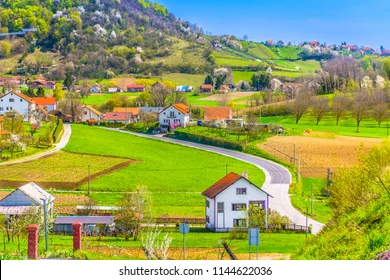Introduction: The Art of Slow, Meaningful Travel
Europe reveals its true character not in crowded plazas or souvenir shops, but in quiet village squares where elderly men play chess, in family-run bakeries where the morning’s bread emerges golden from wood-fired ovens, and along footpaths trodden by generations of farmers and shepherds. This is the Europe that most visitors miss—the living, breathing continent that exists beyond the Instagram hotspots and packaged tours.
Local travel isn’t just about geography—it’s a connection philosophy. It means trading rushed itineraries for lingering conversations, bypassing chain restaurants for kitchen tables where recipes pass between generations, and measuring journeys not in passport stamps but in shared stories. In an era of overtourism, this approach becomes revolutionary—a way to preserve Europe’s soul while experiencing its deepest rewards.
Chapter 1: Why Local Travel Matters in Modern Europe
The cobblestones of Dubrovnik’s Old Town have become a cautionary tale. Once a thriving community, the historic center now sees 80% of its apartments listed as short-term rentals, forcing residents to the outskirts while cruise ship crowds shuffle through by day. Similar stories unfold from Barcelona to Santorini, where the economics of mass tourism prioritize quantity over quality, transforming living cities into theme park versions of themselves.
Local travel offers an antidote. When you stay in a family-run guesthouse in Slovenia’s Julian Alps, your euros support three generations working the same land their ancestors did. When you join a Sardinian grandmother making culurgiones (the island’s signature pasta), you’re not just learning to fold dough—you’re helping safeguard a culinary tradition. This kind of travel creates micro-economies that value authenticity over volume, ensuring Europe’s diverse cultures don’t become museum exhibits.
The environmental argument proves equally compelling. Taking the overnight train from Paris to Venice emits 90% less CO2 than flying. Hiking between Alpine villages leaves no footprint beyond boot prints in meadow grass. Even small choices—like dining at a farm-to-table taverna in Crete rather than a multinational restaurant with imported ingredients—accumulate into meaningful impact.
Chapter 2: How to Travel Like a Local
Choosing where to go requires recalibrating your compass. Instead of Rome, consider Viterbo—a medieval walled city just 80 kilometers north where thermal springs bubble up in Etruscan-era pools still used by locals. Rather than Edinburgh’s Royal Mile, explore the fishing villages of Fife’s East Neuk, where creel-caught lobster arrives on plates within hours.
Accommodations set the tone for immersion. In Portugal’s Alentejo region, centuries-old montado farms welcome guests to help harvest cork bark—a sustainable industry where trees are carefully stripped by hand every nine years. Austrian Bauernhofs (working farms) offer feather beds and breakfasts of house-smoked speck, with optional cheese-making workshops. Even in cities, options exist beyond generic hotels—try a Zagreb artist’s spare room booked through cultural exchange platforms, or a Parisian chambre de bonne where your morning croissant comes wrapped in paper from the boulangerie downstairs.
Transport becomes part of the adventure when approached locally. Switzerland’s PostBus system reaches hamlets so remote they receive mail just twice weekly. Ireland’s island-hopping ferries double as grocery deliveries for Atlantic outposts. For the ultimate slow journey, walk sections of the Via Francigena—the ancient pilgrim route from Canterbury to Rome—staying in donativo (donation-based) hostels where modern walkers share tables with Italian nonnas serving minestrone.
Chapter 3: Europe’s Most Authentic Experiences
In the Romanian Carpathians, the last European wilderness outside Russia, life moves to the rhythm of transhumance. Shepherds from Maramureș still lead flocks along ancient salt roads, their paths marked by wooden churches with Gothic steeples that pierce the sky like needles. Visitors can join these migrations, sleeping in mountain huts where cheese ages on spruce shelves and evenings pass with palinka (fruit brandy) and ballads played on fiddles.
The Faroe Islands offer a different kind of immersion. In the village of Gjógv (population 49), fishermen welcome helpers to mend nets before setting out for the day’s catch. The reward? A kitchen-table feast of freshly boiled crab, rhubarb jam made from backyard plants, and stories about hidden sea caves where puffins nest.
For culinary deep dives, few experiences rival Andalucía’s autumn olive harvest. Families in Jaén province have pressed oil for millennia—today, visitors can join the video, hand-picking arbequina olives before they’re cold-pressed into liquid gold. The true magic comes at lunch, when pickers gather around enormous pans of migas (fried breadcrumbs with pork) under centuries-old oak trees.
Chapter 4: Practical Wisdom for Meaningful Travel
Language unlocks doors that remain closed to most tourists. Beyond polite phrases, learning to ask “What makes this place special to you?” in the local tongue often leads to extraordinary encounters—perhaps an invitation to a Slovenian beekeeper’s honey tasting, or a Breton fisherman’s pre-dawn mackerel run.
Packing light takes on new meaning when traveling locally. Leave space for a linen towel from a Croatian weaving cooperative, or a wedge of cheese wrapped in chestnut leaves from a French affineur. Bring a notebook for recording recipes learned in Greek village kitchens, or the names of wildflowers pointed out by a Swiss Alpine guide.
Timing proves equally crucial. Visit Venice in January when mist wraps the palazzos like velvet and opera rehearsals echo through empty calli. Experience Provence in November, when olive harvest festivals replace lavender-field selfies, and truffle hunters’ dogs sniff through oak groves at dawn.
Conclusion: The Local Travel Mindset
Local travel ultimately demands a shift in perspective—from consuming places to conversing with them. It means understanding that a Hungarian horseman’s csikós demonstration isn’t a show, but a living tradition preserving Puszta grasslands through grazing. It recognizes that a Sicilian fisherman’s early morning excursion isn’t just about catching dinner, but maintaining a balance with the sea that has sustained his family for centuries.
The next time you plan a European journey, ask not what sights you’ll see, but what stories you might exchange. Skip the queue for the Louvre’s Mona Lisa to learn marquetry from a Parisian ébéniste in the Marais. Bypass Munich’s beer halls for a private tasting with a fifth-generation Bavarian hop farmer. In doing so, you’ll discover the Europe that exists beyond postcards—a continent still rich with authentic connections waiting to be made.
Which overlooked European community would you most like to visit? Share your thoughts below—your suggestion might become someone else’s transformative journey.


Leave a Reply